First Drive: The Ford Focus Vignale adds luxury to brilliant hatchback — at a price
Can the upmarket Vignale make a difference to Ford’s excellent Focus? Tom Wiltshire heads to France to find out

What is it?
Ford’s Vignale sub-brand is a bit of an odd beast. That’s because rather than being a manufacturer in its own right, as Lexus is to Toyota, the Vignale Fords are little more than well-specified trim levels with some unique styling and equipment editions.
And so it is with Ford’s Focus Vignale. Ostensibly, this is the most upmarket, most luxurious and most cossetting version of the brand’s mid-sized hatchback. But the Focus has never been about ultimate luxury – rather, driving dynamics, practicality and affordability. What does Vignale have to offer, then?
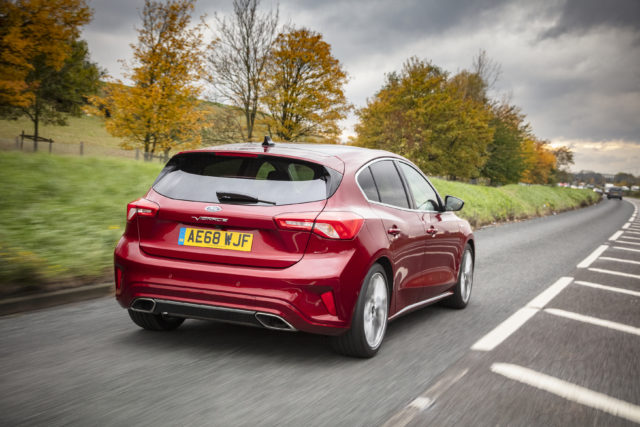
What’s new?
You certainly can’t miss the Vignale makeover. In fact, the car doesn’t even say ‘Focus’ on it, with the badging across the tailgate replaced with the Vignale insignia.
Elsewhere, the Focus takes the same ingredients applied to other Vignale cars in the range such as the Mondeo, Edge and Kuga. That means chrome, chrome and a little more chrome – eye-catching polished 18-inch alloy wheels, a sparkling chrome grille with unique pattern, and a few bespoke body colours.
Inside, the dashboard’s been covered in faux leather, there’s full leather upholstery and generous kit as standard. Vignale models are available in hatchback or estate body-styles.
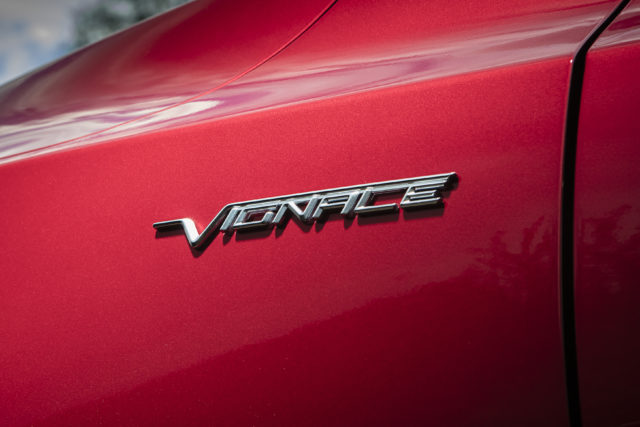
What’s under the bonnet?
Vignale trim is available with the higher-powered engines from the Focus range. Our test car was equipped with the current range-topper – a 2.0-litre diesel, producing 148bhp and mated to an eight-speed automatic gearbox.
It’s an excellent combination for cruising, as the gearing means the car is barely ticking over at 70mph – making for a relaxed ambiance. That’s helped by additional soundproofing in Vignale models.
Around town, though, it’s a little less comfortable. The engine’s rather gruff when pulling off, and feels slightly ponderous at lower speeds. That’s not aided by the gearbox, though it’s far from being the worst of its type is slightly hesitant from a standstill.
The combination isn’t as efficient as you might hope, either – we averaged less than 50mpg over a long motorway cruise. We’d be tempted to avoid diesel altogether and opt for a cheaper and more characterful (albeit thirstier) EcoBoost petrol instead.
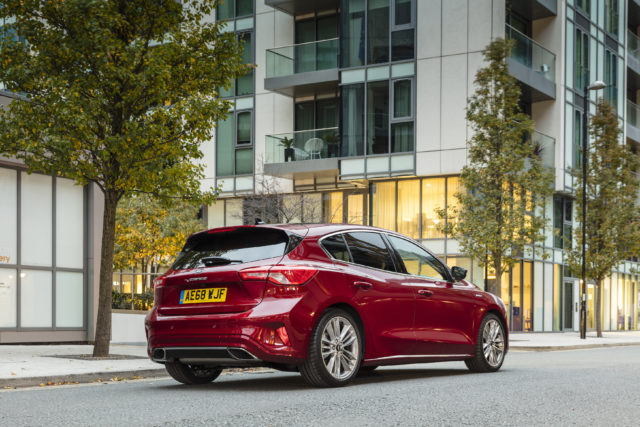
What’s it like to drive?
The Focus is brilliant to drive regardless of trim. Unsurprisingly, Vignale spec does nothing to change that – though you’ll notice the slightly poorer handling than ST-Line models, which have a sports suspension setup.
Is it a deal-breaker? Of course not. The worst the Focus can muster is still miles better than most of its rivals, and if you’re coming to the car from a Volkswagen Golf, a budget rival such as the Hyundai i30 or even a premium car such as the Mercedes A-Class, you’ll adore the way this car handles.
There’s a natural smoothness and balance to all the controls, making the Focus effortless to drive smoothly. Turn up the wick and hustle and it won’t become upset, either – it’s unruffled in corners, comfortable at a fast cruise and still great around town. Some rivals offer more ultimate ride comfort, but not many – and it’s a small price to pay.
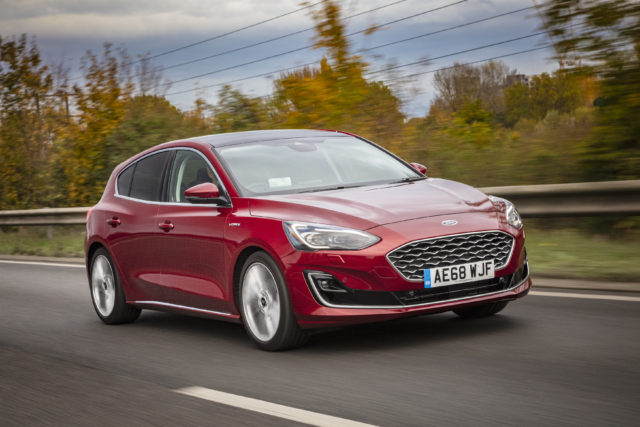
How does it look?
Shrinking violets would be best-off avoiding the Vignale model. The glitzy makeover includes a bright chrome grille, lots of chrome detailing and seriously bold polished alloy wheels. It’s mated to either white, black, red, or deep purple paintwork – some of which are exclusive Vignale shades.
The effect is a little jarring on the Focus, which tends to look at its best in sporty ST-Line trim. We’d go so far as to say the wheels in particular are a little vulgar, though of course personal opinions do differ.
The underlying Focus is still a good-looking car, though. It’s well-proportioned, with good chunky detailing to its styling and a low, wide stance. Vignale models also get full LED head- and tail-lights, a really smart touch which make the car look properly modern.
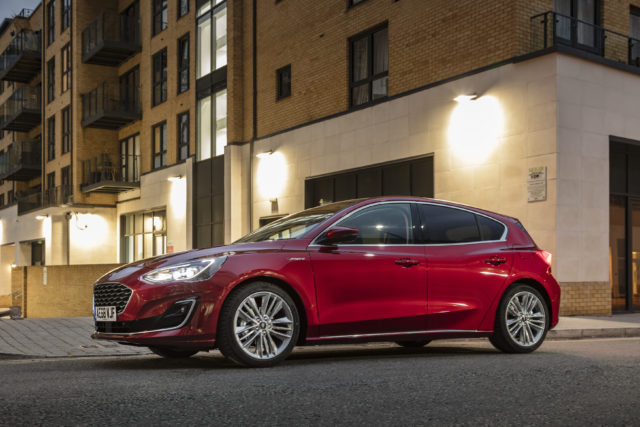
What’s it like inside?
It’s difficult not to be disappointed with the Vignale interior makeover. The full leather upholstery is welcome, but elsewhere, it feels as though Ford’s fixed what didn’t need fixing – and ignored the bits that did.
Take the dashboard and centre console, for example. The dash top is now swathed in faux leather, upgraded from an already very pleasant soft-touch plastic in lesser models. Yet the lower portion of the centre console – with hollow and cheap-feeling plastic, especially around the climate controls – hasn’t seen any improvement. In fact, all Vignale has done is widen the gulf between the good and the bad materials in this cabin.
Thankfully, nothing’s been done to change the car’s excellent layout – with a near-perfect driving position, crystal-clear gauges and a high-set infotainment display that’s easy to interact with.
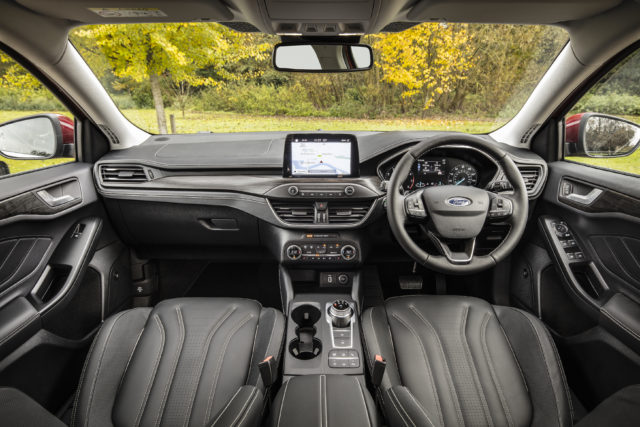
What’s the spec like?
There are quite a few goodies included in with Vignale trim. There’s the aforementioned LED headlights and 18-inch alloy wheels, plus the brilliant automatic door edge protectors – rubber stoppers which deploy from behind the door and prevent damage should it be opened into a solid surface.
Also standard is a reversing camera, active parking assist, LED mood lighting, a heads-up display, a heated steering wheel and a brilliant B&O audio system. Though it comes at a price – almost £30,000 for our top-end diesel automatic – Vignale’s equipment level is certainly generous.
Head to the options list and you’ll find blind-spot monitoring, traffic sign recognition, adaptive front lighting, a hands-free tailgate and an electric tailgate.
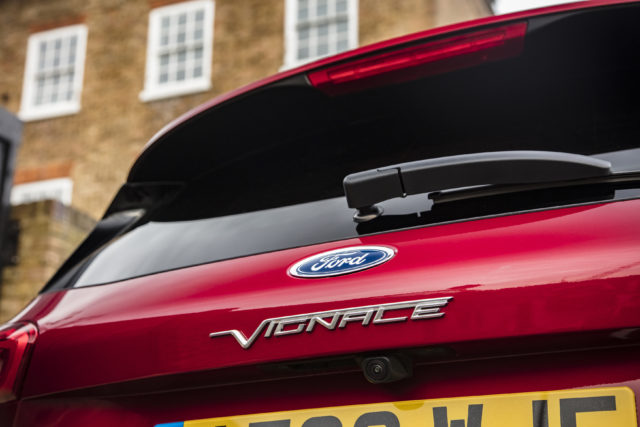
Verdict
Ford introduced Vignale to its range after realising that its customers wanted something more upmarket than the existing Titanium X trim level. On that score, the Focus Vignale wins – it’s well equipped and usefully distinguishable from lesser trims thanks to its unique styling details. It does feel a little half-baked in places, particularly the interior materials, but when the underlying car is as good as the Focus, that’s easy to overlook.





